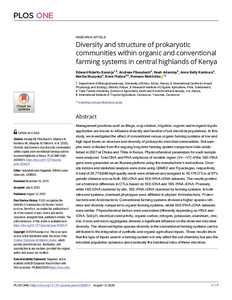| dc.contributor.author | Karanja, E.N. |
| dc.contributor.author | Fliessbach, A. |
| dc.contributor.author | Adamtey, N. |
| dc.contributor.author | Kambura, A.K. |
| dc.contributor.author | Musyoka, M. |
| dc.contributor.author | Fiaboe, K. |
| dc.contributor.author | Mwirichia, R. |
| dc.date.accessioned | 2022-08-25T13:39:39Z |
| dc.date.available | 2022-08-25T13:39:39Z |
| dc.date.issued | 2020 |
| dc.identifier.citation | Karanja, E.N., Fliessbach, A., Adamtey, N., Kambura, A.K., Musyoka, M., Fiaboe, K. & Mwirichia, R. (2020). Diversity and structure of prokaryotic communities within organic and conventional farming systems in central highlands of Kenya. PloS ONE, 15(8): e0236574, 1-17. |
| dc.identifier.issn | 1932-6203 |
| dc.identifier.uri | https://hdl.handle.net/20.500.12478/7692 |
| dc.description.abstract | Management practices such as tillage, crop rotation, irrigation, organic and inorganic inputs application are known to influence diversity and function of soil microbial populations. In this study, we investigated the effect of conventional versus organic farming systems at low and high input levels on structure and diversity of prokaryotic microbial communities. Soil samples were collected from the ongoing long-term farming system comparison trials established in 2007 at Chuka and Thika in Kenya. Physicochemical parameters for each sample were analyzed. Total DNA and RNA amplicons of variable region (V4—V7) of the 16S rRNA gene were generated on an Illumina platform using the manufacturer’s instructions. Diversity indices and statistical analysis were done using QIIME2 and R packages, respectively. A total of 29,778,886 high quality reads were obtained and assigned to 16,176 OTUs at 97% genetic distance across both 16S rDNA and 16S rRNA cDNA datasets. The results pointed out a histrionic difference in OTUs based on 16S rDNA and 16S rRNA cDNA. Precisely, while 16S rDNA clustered by site, 16S rRNA cDNA clustered by farming systems. In both sites and systems, dominant phylotypes were affiliated to phylum Actinobacteria, Proteobacteria and Acidobacteria. Conventional farming systems showed a higher species richness and diversity compared to organic farming systems, whilst 16S rRNA cDNA datasets were similar. Physiochemical factors were associated differently depending on rRNA and rDNA. Soil pH, electrical conductivity, organic carbon, nitrogen, potassium, aluminium, zinc, iron, boron and micro-aggregates showed a significant influence on the observed microbial diversity. The observed higher species diversity in the conventional farming systems can be attributed to the integration of synthetic and organic agricultural inputs. These results show that the type of inputs used in a farming system not only affect the soil chemistry but also the microbial population dynamics and eventually the functional roles of these microbes. |
| dc.description.sponsorship | Biovision Foundation |
| dc.description.sponsorship | Swiss Coop Sustainability Fund |
| dc.description.sponsorship | Liechtenstein Development Service |
| dc.description.sponsorship | Swiss Agency for Development and Cooperation |
| dc.description.sponsorship | UKAid |
| dc.description.sponsorship | Swedish International Development Cooperation Agency |
| dc.description.sponsorship | Federal Democratic Republic of Ethiopia |
| dc.description.sponsorship | Kenyan Government |
| dc.format.extent | 1-17 |
| dc.language.iso | en |
| dc.subject | Farming Systems |
| dc.subject | Organic Agriculture |
| dc.subject | Crop Rotation |
| dc.subject | Soil Fertility |
| dc.subject | Kenya |
| dc.title | Diversity and structure of prokaryotic communities within organic and conventional farming systems in central highlands of Kenya |
| dc.type | Journal Article |
| cg.contributor.crp | Roots, Tubers and Bananas |
| cg.contributor.affiliation | University of Embu |
| cg.contributor.affiliation | International Centre of Insect Physiology and Ecology |
| cg.contributor.affiliation | Taita Taveta University |
| cg.contributor.affiliation | International Institute of Tropical Agriculture |
| cg.coverage.region | Africa |
| cg.coverage.region | East Africa |
| cg.coverage.country | Kenya |
| cg.coverage.hub | Central Africa Hub |
| cg.researchtheme | Natural Resource Management |
| cg.identifier.bibtexciteid | KARANJA:2020a |
| cg.isijournal | ISI Journal |
| cg.authorship.types | CGIAR and developing country institute |
| cg.iitasubject | Agronomy |
| cg.iitasubject | Crop Systems |
| cg.iitasubject | Farming Systems |
| cg.iitasubject | Soil Fertility |
| cg.journal | PLOS ONE |
| cg.notes | Published online: 13 Aug 2020 |
| cg.accessibilitystatus | Open Access |
| cg.reviewstatus | Peer Review |
| cg.usagerightslicense | Creative Commons Attribution 4.0 (CC BY 0.0) |
| cg.targetaudience | Scientists |
| cg.identifier.doi | https://dx.doi.org/10.1371/journal.pone.0236574 |
| cg.futureupdate.required | No |
| cg.identifier.issue | 8 |
| cg.identifier.volume | 15 |

